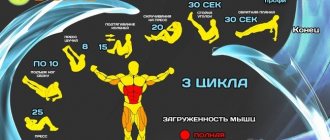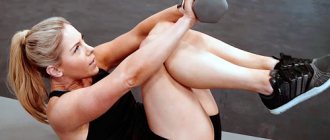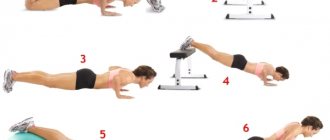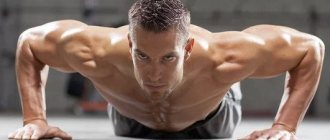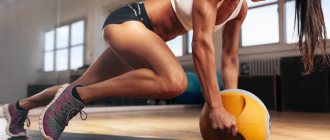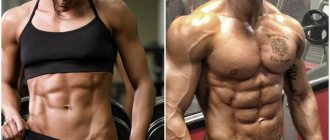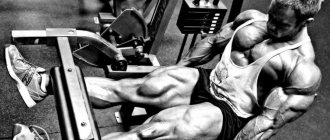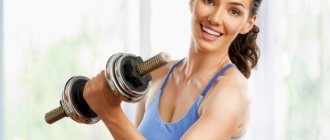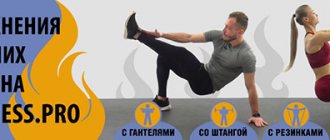Why would it be difficult to make your shoulders bigger by training only with your own weight?
Before moving on to describing a set of home exercises, you should warn about the complexity of such a path. Deltas, just like any other muscles, develop effectively if several conditions are met:
- Presence of stress. This means a load that is excessive for the current capabilities of the body, leading to micro-tears of muscle fibers.
- Sufficient rest period. It is during recovery that an increase in body volume occurs, since during the healing process micro-tears are filled with new tissue.
By training only with your own weight, at a certain point your body will completely adapt to the load and muscle growth will stop. It is impossible to increase the intensity of training only by increasing the number of repetitions ad infinitum. In this way, you will move away from building mass towards developing endurance. All that remains is to come up with different variations with the range of motion and resort to supersets (a combination of different types of load without rest between them). But only a professional, and not a beginner practicing on his own, can create a competent training program taking into account such subtleties.
Exercises without weights and in terms of targeting certain areas of the shoulder muscles are limited. The deltoid muscle consists of 3 types of bundles:
- the front one, responsible for moving the arms towards oneself and upward;
- middle (lateral), allowing you to spread your arms to the sides;
- posterior, responsible for abducting the arms behind the back.
Most bodyweight exercises work the front and side deltoids, while the rear deltoids are often neglected.
Training at home makes sense in two cases:
- At the initial stage, when the body is completely untrained. Exercises with your own weight will tone your muscles, teach you to feel your own body and help you pump up a little.
- In the absence of great ambitions, when it is enough to acquire at least some kind of sports form, without building powerful muscles.
It is effective to start your sports journey with home workouts, and when the load is not enough, you can already go to the gym.
Shoulder exercises with body weight
If the goal is to increase the volume of the deltoid muscles, then there is not such a large arsenal of exercises with your own weight. They can be divided into 2 groups:
- various types of push-ups;
- pull-ups and push-ups using a horizontal bar and parallel bars.
In order for all deltoid muscle bundles to develop evenly, a home bodyweight training program should include multidirectional exercises from each of these groups.
Pushups
Classic push-ups work 3 types of muscles - pectoral, triceps and deltoids. But regarding the deltas, we are talking only about the anterior beam, since the middle and rear ones remain unused in this exercise. If your anterior muscle is lagging, then only push-ups while lying down will be enough to solve the problem, otherwise this exercise can only be part of a shoulder training with your own weight.
Technique:
- We take an emphasis lying on straight arms. Place your palms at a distance slightly wider than shoulder width. The feet rest with their toes on the floor, the distance between them is 15-20 cm. The whole body is elongated in an even line.
- We lower ourselves down by bending our elbows until our chest touches the floor.
- Let's go back up.
- Breathing - inhale when lowering, exhale when rising.
We do 4 sets of 15-20 repetitions. In push-ups, it is customary to change the direction of the load by rearranging the hands. So, if you place your arms a little wider, the emphasis shifts to the pectoral muscles, and with a narrow position, the emphasis shifts to the triceps. However, such manipulations have virtually no effect on the effectiveness of pumping the deltoid muscles, so you can stick to the classic version.
Ball push-ups
After the body adapts to the load from classic push-ups, you can move on to more complicated versions of this exercise. For example, use a medicine ball (medicine ball) in it.
Technique:
- The starting position is a classic prone position, only the hands are placed not on the floor, but on the ball.
- Balancing on the ball, we slowly lower ourselves down and then rise back up.
In such push-ups, due to the narrow placement of the arms, the emphasis is on the triceps. But instability of the support significantly increases the load on all muscle groups involved in this basic exercise, including the anterior deltoids.
Elevated leg push-ups
Another way to make push-ups harder is to place your feet higher than the front of your body.
Technique:
- The starting position is the same as in classic push-ups, only we place our legs on an elevated platform. To do this, you can use a step platform, a bench, or any homemade means.
- Slowly lower yourself down, trying to bring your chest as close as possible to the floor, then rise back.
- We carefully monitor the position of the body. It should stretch into a straight line without bending in the lower back, both inward and outward.
The higher the elevation, the more we load our arms and shoulders. You can start by positioning your body to the floor at an angle of 35-40 degrees (when lowering to the lowest point). In the future, you should increasingly increase the load by increasing the angle of inclination.
Wall rack push-ups
Handstand push-ups are a logical continuation of the previous exercise. In a vertical position, we remove the load from the pectoral muscles, directing it as much as possible to the arms and shoulders. Moreover, unlike horizontal push-ups, in this case all bundles of the deltoid muscle are involved.
Technique:
- We stand opposite the wall at a distance of 1.5-2 meters. Then we take an energetic step forward, place our hands on the floor and, due to inertia, throw our legs up. The distance between the hands and the wall should be 10-15 cm, and between the palms a little more than shoulder width. Keep your legs straight.
- Slowly lower yourself down by bending your elbow joints, bringing your head closer to the floor. We do not lower our head to the floor completely, so as not to create a compressive load on the spine and to avoid injury from a sharp blow.
- We also slowly rise back.
The exercise is complex, and you can move on to it only after mastering simpler methods of push-ups. Moreover, it is better to start with half-push-ups with an incomplete amplitude until your arms are sufficiently strong. The number of repetitions should gradually be increased to 10-15 in 2-3 approaches.
Dips
Just as in the case of the prone position, dips on the uneven bars engage only the front delta. But the more varied exercises you include in your training program, the more stress your muscles will experience, thereby accelerating their transformation. Therefore, the bars should not be neglected.
Technique:
- We take the starting position, placing the body perpendicular to the bars. Arms are straightened, legs are crossed.
- As you inhale, move your body forward, slowly bending your elbow joints.
- As soon as you feel a slight burning sensation in the pectoral muscles, we stop for a couple of seconds, after which we return to the original position.
- We repeat the movement 10-12 times, and so on for 3-4 approaches.
It is important to choose the correct width of the beams. It should not be much wider than the width of the shoulders, otherwise it creates a dangerous load on the joints.
Classic pull-ups
There is a horizontal bar in almost every yard, so everyone can afford to include exercises on it in their training program. In the classic version, pull-ups load the front deltoids.
Technique:
- We hang on the crossbar with straight arms. We bend our back at the lower back, cross our legs. The palms are located away from you, the distance between them corresponds to the width of the shoulders.
- As you exhale, slowly pull yourself up until your chest touches the horizontal bar. At the top point your face should be above the bar.
- We lower ourselves down, inhaling.
- We repeat the movement 15-20 times. We do 3-4 approaches in total.
If you perform the same exercise with a reverse grip (palms facing you), the rear deltas will be activated.
Australian pull-ups
Not everyone can immediately start doing pull-ups using the classic method. Therefore, you can start with lighter horizontal pull-ups, or, as they are also called, Australian pull-ups. To perform them you will need a low horizontal bar. In the hall it can be replaced with a bar located on racks.
Technique:
- We hang on a low horizontal bar, stretching our legs forward until the body is completely straightened. In this case, an acute angle should form between you and the floor. We place our palms as wide as possible in order to maximally direct the load on the rear delts, and not on the back.
- As you exhale, pull your chest toward the horizontal bar, bringing your shoulder blades together.
- As we inhale, we go back.
- We do 15-20 repetitions in 3-4 approaches.
When performing the exercise, it is important to bring your shoulder blades together completely. If you do not have time to do this before touching the bar, you need to move your legs forward a little more.
Bent-over dumbbell raises
This exercise works the posterior deltoid muscle. Developed rear deltas give the shoulders a fully developed, rounded appearance. Of all the shoulder muscles, this is usually the most difficult muscle to tone. It is worked out during a pulling movement with weights, but when the body is not straightened, but tilted forward.
How to do it:
- Stand up and bend your torso forward towards the floor. Keep your lower back straight so that your torso is almost parallel to the floor. Keep your head in a neutral position and do not pull your neck upward.
- Take dumbbells in your hands. Hands are lowered in front of you, palms facing each other. Make sure your elbows are relaxed and slightly bent.
- Engage your rear delts and pull your elbows up, spreading your arms out to the sides. The dumbbells should be at the top, almost parallel to the floor, with your palms facing down.
- Avoid body rocking. Keep your core tight throughout the movement.
- Aim for 2 to 3 sets of 12 to 15 reps.
Conclusion
To properly work out your shoulders, you don’t need to have some fancy equipment on hand or go to the gym. If you incorporate these exercises into your regular workout routine, you will see noticeable improvements within a few weeks.
Just remember to use proper form and go through a full range of motion to ensure your shoulder muscles are working and developing correctly. Once you have mastered these exercises, begin to make them more difficult by gradually increasing the number of repetitions.
Articles on our website are presented for educational and informational purposes only. We do not recommend using article materials as medical advice. If you decide to take dietary supplements or make fundamental changes to your diet, first consult with a specialist.
Translation: Farida Seidova
Are you training at home? Then you will also be interested in this article:
Workout
Exercises without stress on the spine using a 70-75 degree bench
In many sports exercises, the load is directly or indirectly placed on the spine. This can be harmful for people with back pain, as well as for teenagers whose skeleton has not yet fully formed. These are mainly exercises with free weights in a standing or sitting position without support. Many of them are easy enough to secure using a bench with an adjustable backrest. The angle of the backrest to the floor should be 70-75 degrees. Let's consider options for shoulder exercises from this position.
Seated barbell press
The seated barbell press allows you to pump up your front deltoids.
Technique:
- We hold the bar with a straight grip at chest level. Shoulders straightened. With a narrow position of the arms, only the front deltas are involved, and with a wide position, the middle beam is involved in the work.
- As you exhale, straighten your arms, lifting the barbell up.
- As you inhale, slowly return the projectile to its original position.
- We do 10-12 repetitions in 3 sets.
If the weight is incorrectly selected, the exercise can cause injury to the shoulder joint. Therefore, at first it is important not to overestimate your own capabilities.
Smith machine barbell press
The exercise is similar to the previous one, but is safer for the joints due to the movement of the bar along the guides. In addition, when exercising in a Smith machine, there is no need to control the balance of the barbell, which eliminates the stabilizer muscles from the work, making the exercise more isolated.
Exercises with dumbbells
While sitting on a bench, you can perform 3 types of exercises with dumbbells:
- bench press;
- breeding;
- rise in front of you.
The seated dumbbell press loads the front and side muscles. To perform it, arms with dumbbells are spread to the sides and bent at the elbows at a right angle. As you exhale, the projectiles rise upward until your arms are fully straightened, and as you inhale, they return to their original position.
To perform arm raises with dumbbells, you must not sit down on the bench, but lie down on your stomach. In this case, your arms, slightly bent at the elbows, should hang on both sides of the back. As you exhale, slowly raise your arms up through your sides until your shoulders are parallel to the floor. As you inhale, lower back. The exercise involves the rear deltas.
Raising dumbbells in front of you allows you to work your front and middle deltoids. The movements are performed with slightly bent elbows so that the load falls exclusively on the shoulders. As we exhale, we raise our arms no higher than the level of the chin, after which we slowly return them back. The movement can be performed with both hands at once with a distance between them equal to shoulder width, or alternately.
Program for developing the shoulder girdle in the gym: 3 times a week
The optimal option for exercising in the fitness center is 3 times a week.
First day.
- Pulling the exercise machine with the upper block to the chest.
- Curling arms with a barbell.
- Pull-ups on the horizontal bar with alternating hand grips.
- Lifting a barbell on an incline bench machine.
Second day.
- Raising the dumbbells upward from the sides, returning them to the chest.
- Pull the upper block to the chest (hand grip is wide).
- Bent-over dumbbell lifts to abdominal level.
- Reduction of arms on the butterfly simulator.
- Push-ups from the floor or bench.
The third day.
- Raise dumbbells in front of you to chest level.
- Burpees.
- Push-ups from parallel bars or from your knees.
The barbell to chin row is a basic shoulder exercise for girls. - Pull the bar to the chin.
- Stretch the expander upward while standing in its center with both feet.
Perform the exercise 10-15 times in 3 circles. The weight of dumbbells and barbells is commensurate with physical fitness. Heavy equipment will not allow you to complete the entire lesson efficiently. Tasks can be alternated. Rest between sets from 60 to 90 seconds.
Optimally, to maintain physical fitness, exercise three days a week, from 40 minutes to an hour, working all the muscles . You should rest a day or two between workouts.
Don't miss the most popular article in the section: Body drying for girls. Training program, detailed nutrition menu for the month by day.
How to combine bodyweight exercises and weight training?
We have already mentioned the low effectiveness of exercise without weights for gaining muscle mass. If you can't go to the gym, you can add a strength component to your program with free weights. To do this, you need to purchase dumbbells or weights, and if this is not possible, replace them with improvised means. For example, load the backpack with something heavy, or sew weights yourself and fill them with sand.
Different types of exercises must be performed sequentially - first we train with weights, then we “finish off” the muscles with pull-ups or push-ups. This program will allow you to work out your muscles better with less time. You can also use the principle of pre-fatigue. By working with your own weight before doing dumbbell exercises, you can get more benefits from your strength training. These types of workouts are high intensity, so before you start, be sure to warm up your muscles well and stretch to eliminate the risk of injury.
How to speed up progress with sports nutrition?
When it comes to building muscle, nutrition is even more important than the workout itself. Muscles will only grow if you receive enough nutrients, which is not always possible to provide with regular foods. For those who are unable to eat a lot often, sports supplements will come to the rescue. When training for weight, you cannot do without the following products:
Protein. Supplies the body with protein – the main building material. Absorbed 10-15 times faster than regular food. It does not contain excess fats and carbohydrates.
Amino acids. They perform the same functions as protein powder, but are absorbed faster, since the protein is already in a split form.
Creatine. Increases explosive muscle strength.
Omega 3 and 6 fatty acids. Accelerate muscle growth and generally have a positive effect on health.
Vitamin and mineral complexes.
Sports nutrition will only give results if the rest of your diet consists of balanced meals. No matter how useful it is, it is still only an addition to the main diet.
For those who are just deciding whether they need sports nutrition, we recorded a video below:
We recommend: a sports nutrition site with the coolest and most effective assortment!
Program for developing the shoulder girdle in the gym: 5 times a week
First day.
- Push-ups from the floor.
- Raising the barbell from the chest.
- Arnold press.
- Raising dumbbells to the sides.
- Pull-ups on the horizontal bar, with alternating grip changes.
Second day.
- Kettlebell rows in a standing position with alternating hands.
- Seated barbell press on a Smith machine.
- Bent over dumbbell swings.
- Elbow plank.
- Dumbbell swings.
The third day.
- Push-ups in the gravitron.
- Dumbbell raises from the sides up.
- Classic barbell lift in a prone position.
- Squats with a barbell.
- One-arm T-bar press.
Fourth day.
- Elbow plank.
- Bench press in a sitting position from behind the head.
- Bench push-ups.
- Reduction of arms in the butterfly simulator.
- Barbell chest press with arms raised.
Fifth day.
- Pull-ups with direct and reverse grip.
- Lifting dumbbells in a sitting position.
- Bar push-ups.
- Bench press while standing behind your head.
- Lifting dumbbells to chin level.
Perform the exercise 10-15 times in 3 circles. Tasks can be changed. The break between sets is 1-2 minutes.
Summary
You can tone up your shoulder muscles a little with bodyweight training, but you can only make them truly powerful by adding strength exercises to your program. If you wish, you can actually perform them even at home, and if you have back problems, you can always modify the exercises to a safer technique.
Similar articles
- Shoulder exercises
Read more - The best shoulder exercises for mass
Read more
- Back and shoulders training in one day * Program…
Read more
- Shoulder exercises in the gym are the best...
Read more
- Shoulder exercises in the gym for girls...
Read more
4 21
Did you like the article? Share with friends:
We recommend reading:
Exercises after a shoulder dislocation to strengthen and develop arm muscles
How to pump up your shoulders with push-ups at home?
Shoulder weight training - basics, program and best exercises!
Exercises for shoulder and neck pain – “gymnastics 911” for treating shoulder injuries!
Exercises for the posterior delta of the shoulder: a set of exercises in the gym and at home
Discussion: 4 comments
- King Harlekin says:
Mega respect for promoting weightless training. I have nothing against gyms, but you don’t have to live by them alone) True, there are a little more shoulder exercises in calisthenics, but many are complex and require preparation. Write more programs and exercises for experienced ones and you will become my favorite sports site)) - #39K says:
If you combine shoulder training without weights and with weights, which one should you start with? And how much exercise is best?
- DragonoXneko says:
Cool article. It’s ideal for me because the doctor forbade axial loads, but I need to pump my shoulders somehow. I don’t even do biceps and triceps while standing.
- Max Workout says:
I advise you not to switch to weights later, the muscles will work differently. When I reached the point that all bodyweight exercises were easy, I began using a vest with sand. 15-20 kg and damn hard)
